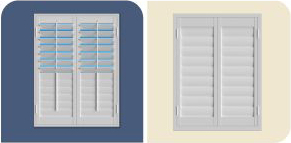
3 Ways Polywood Shutters Are Better Than Hollow Vinyl And Composite Shutters In San Jose, CA
December 15, 2015
Plantation shutters in San Jose come with different options. And when you are figuring out which non-wood shutter fits your home best, it’s not easy to distinguish the differences. You can easily make the wrong choice and end up buying shutters that won’t last. Wondering if Polywood® shutters - our best-selling solid polymer shutters - are a better investment than hollow vinyl or MDF (multi-density fiberboard) shutters? Find out the three ways Polywood shutters are preferred over composite shutters in San Jose, CA to help you decide.
1. Polywood vs Composite Shutters Durability
Polywood shutters are crafted from a top grade solid polymer that ensures the most rigidity, color-retention, and durability than any other shutter on the market. This means the shutter louvers won't be damaged as long as they’re on the window. On the other hand, composite shutters are fabricated from a pressed-board core, enveloped in poly-vinyl. The vinyl enveloping the pressed board is likely to peel off from the core substance quickly. And this peeling happens even faster in hot, humid, and wet environments. Hollow vinyl shutters are another option for non-wood shutters. But they deteriorate the fastest due to the material.Both kinds of non-wood shutters are susceptible to deterioration and warping under varying climate conditions in San Jose. Polywood is built with UV inhibitors that deflect heat. And since heat is the leading culprit in cracking the shutter louvers, Polywood is without a doubt the most durable plantation shutter you can find.
2. Polywood vs Composite Shutters Color Fastness
Polywood shutters come in three exceptional white paints. The paint finishes are baked on each piece at hot temperatures that exceed any temperatures San Jose could experience. Our patented finishing process uses UV inhibitors to ensure the color doesn’t fade.
Other types of non-wood shutters are available in low quality paint finish. And some composite shutters won’t even have any paint finish at all. In most cases, the vinyl wrap is the final color. This finish may look good initially, but it fades as time goes by. And when it comes to hollow vinyls, some are painted. But since the material conducts heat, this adversely affects the finish as time goes by.
3. Polywood vs Composite Shutters Energy Efficiency
Third party tests illustrate that Polywood shutters block up to 30° of temperature and reduce heat transfer by up to 45%. With that, Polywood insulates up to 70% better than even the best solid wood shutter.
These insulating properties are due to the solid polymer material Polywood shutters are made from. Yet what sets Polywood apart even more from composite shutters is the weatherstripping on the louvers and panels. Just interlock the weatherstripping pieces while closing the panels and you get the tightest seal possible against the impact of the weather outside. No composite shutter can offer the energy savings that Polywood does.
The Sunburst Team In Vegas’s First Hand Experience With The Durability Of Polywood Shutters
In 2004, Sunburst Shutters Las Vegas had Polywood shutters anchored to the sides of their trucks as part of the graphics. The trucks were parked outside and endured the natural elements Nevada is known for. That’s extreme heat for more than five months a year!
Those plantation shutters had been fastened to our company trucks for almost 7 years at that point. Our team carried out an investigation on how well Polywood retained the color painted on it. The team dusted off the Polywood shutter that was on the truck. And we compared it side by side to a new Polywood. The color hadn’t changed one bit. There was no fading or discoloration. It further validated for the team that this paint finish is truly top quality!
And knowing that Polywood can handle that much abuse and heat on the road for over 7 years, it’s without a doubt the strongest shutter for your house in San Jose, CA.


